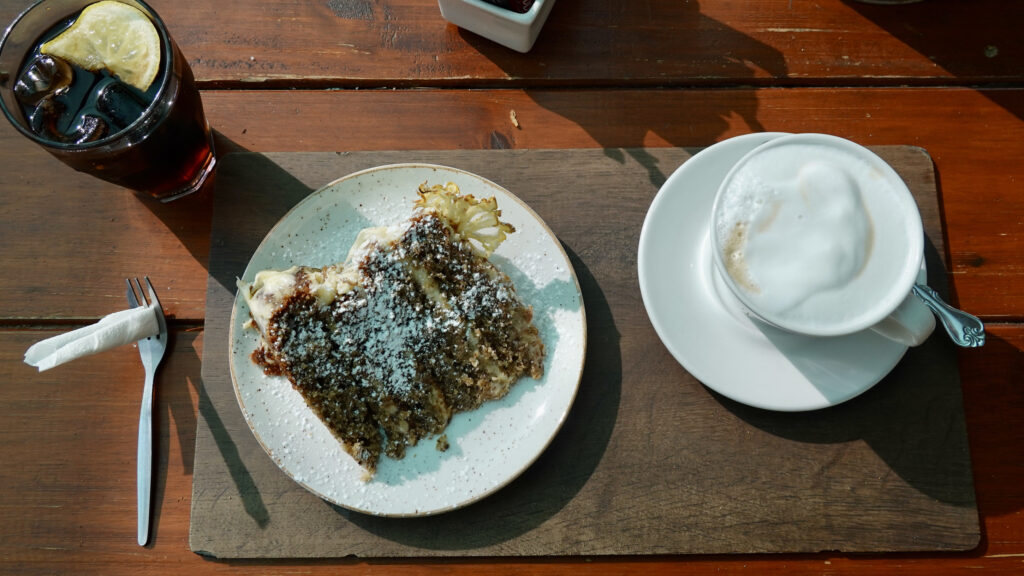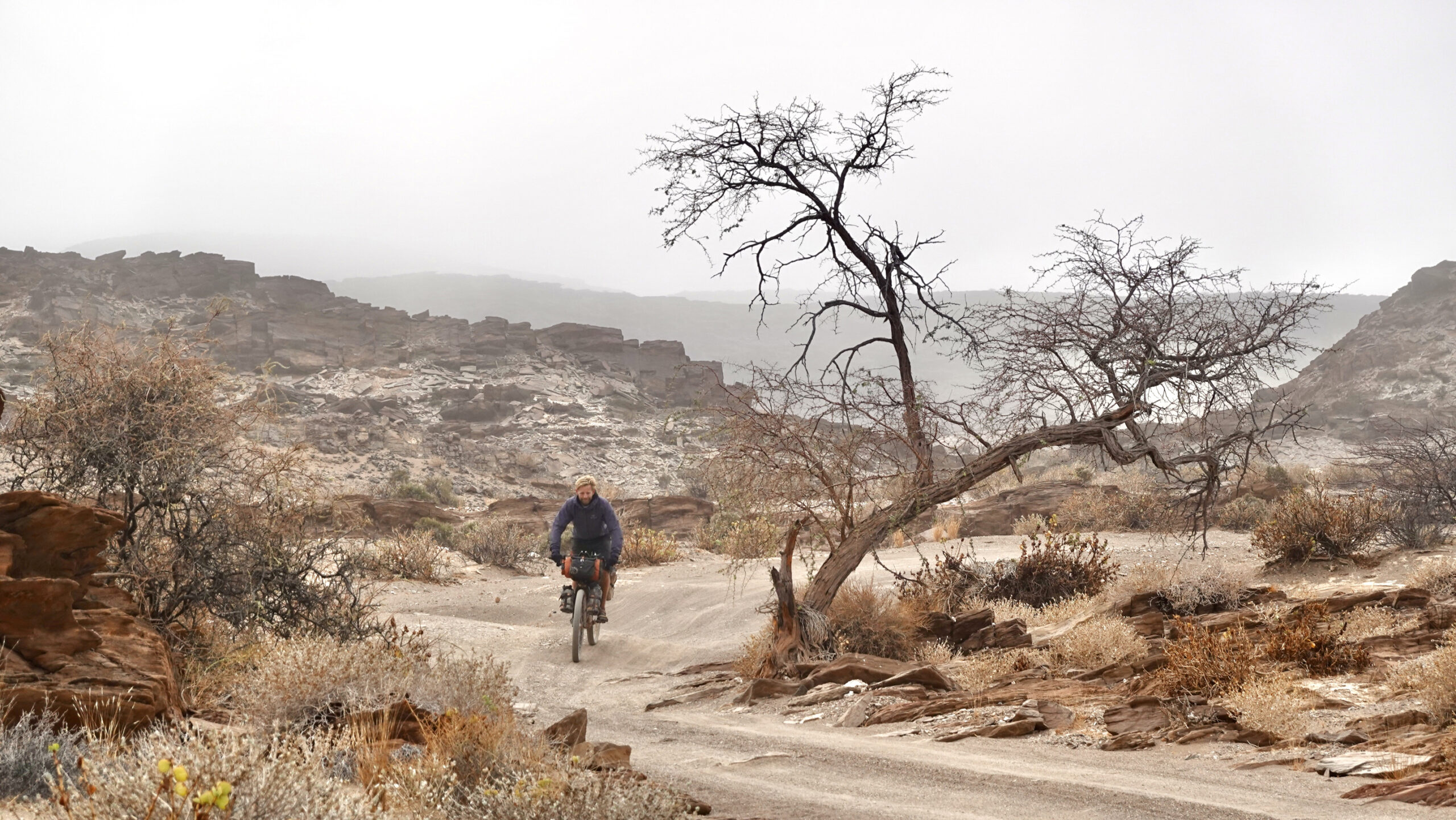Namibia has a force of nature as great and raw as few other places in the world.
As we cycle through the vast desert landscapes, we meet indigenous people who have lived here for thousands of years.
We are fascinated by their abilities for survival, while at the same time we ourselves have to think very carefully, so as not to die of thirst.
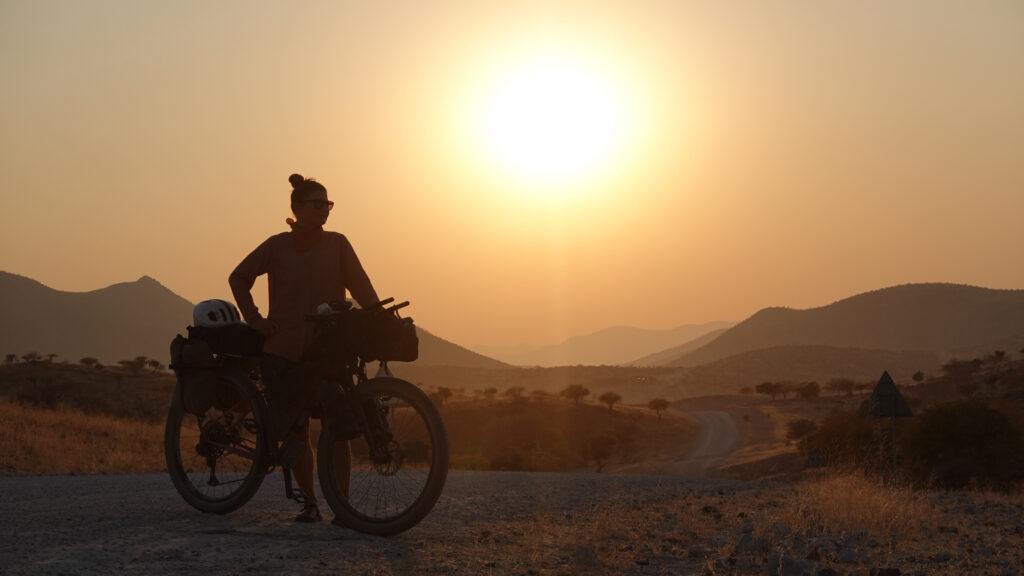

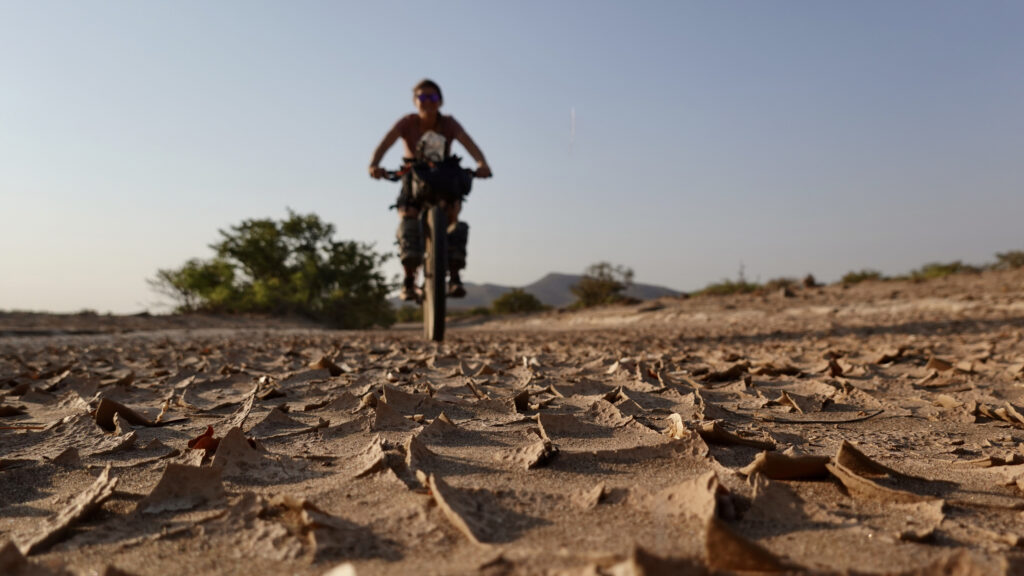
In the northwesternmost corner of Namibia, lies Kaokoland:
“This vast tract of land is Namibia at its most enticing – and yet most inhospitable.
Kaokoland appeals to the adventurer and explorer in us, keeping quiet about the dangers involved.”
...this is how the guidebook begins the chapter on Kaokoland, where we start our route through Namibia. An inhospitable, impassable, but also strangely alluring mythical desert landscape, which calls to the adventurer in the soul.
Or as they write later:
“For this you should ideally have a two-vehicle 4×4 expedition, all your supplies, an experienced navigator, detailed maps and good local advice on routes. Even then, you will probably get lost a few times.”
…We had two bikes and lots of walking.
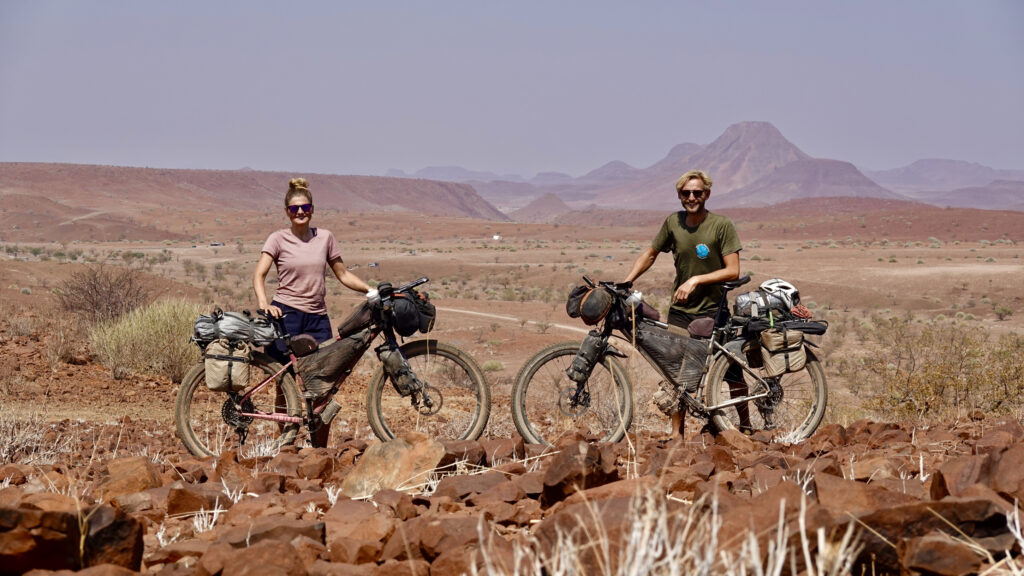
The domain of the Himba
The first two days, we cycled along the Kunene river, up to Epupa. The heat was extreme because the air is completely still in the low valley. Sweat dripped down the handlebars as we bulled our way up the steep rocky hills before we could get a breath of fresh air every time we rolled down the other side. The landscape is raw, but the river gives life to a narrow belt of green trees and tiny villages inhabited by the Himba.
The Himba are a wonderfully visual people. They exude a great pride with their insistence on being dressed completely traditionally. The men are a little toned down compared to the women, but they still have a special system of fabric as trousers. It has two layers, one short and one longer. Their hair is styled in certain ways depending on whether they are single or married. And they wear a very specific type of sandal, which is nailed together from old car tires.
But the women - they have a completely different, extremely beautiful and very distinctive expression. The contrast to the modern world is enormous when you see a Himba woman in all her traditional expression: the hair is shaped into long pigtails and both the skin and the hair are smeared with an ocher colored grease, called otjize. The Himba live in areas where there are long periods of drought, so they cannot wash regularly. Many Himba have not bathed in years, but keep themselves clean with otjize, which also protects against the harsh sun and crisp air, as well as insect bites. Often, otjize is mixed with aromatic extracts of the omuzumba bush, so that it also acts as a 'deodorant'.
But first and foremost, otjize is an aesthetic choice for Himbak women. The ochre-red color symbolizes blood and the red earth, which is associated with life itself.
On the lower body, the women have a goatskin skirt. If they have children, they have a cloth cloth, which forms a small rucksack, tied around their waist. On the upper body, they only wear jewelry above their bare breasts.
It is an extremely fascinating term which is very powerful. We have seen completely traditional Himba women in some of the larger cities, where the contrast between an almost naked woman in a modern supermarket is quite wild. But precisely because the Himba stick to their traditional appearance, they appear proud and strong. We think back to the Bakers in the Cameroonian jungle, who, in comparison, seemed like a broken people, unable to reconcile their thousand-year-old traditions and life with the modern world. The Himba seem to be stronger in that battle.
Of course we wanted to take pictures of the Himba, but they are difficult to get into, so we didn't manage to make good enough friends with anyone that we could ask to photograph. The embarrassment of asking if you can take a picture is undeniably even greater when the person is almost naked. On the other hand, we learned that the Himba themselves see it as a business to have pictures taken. They are used to all the tourists wanting to photograph them. In a way, it's also a much more pure barter than if we as privileged whites try to be friends for a while, just to take a picture. So when we met two beautiful Himba women on the dirt road to Epupa, we had no problem giving them the money they asked for in exchange for some great photos as good memories.
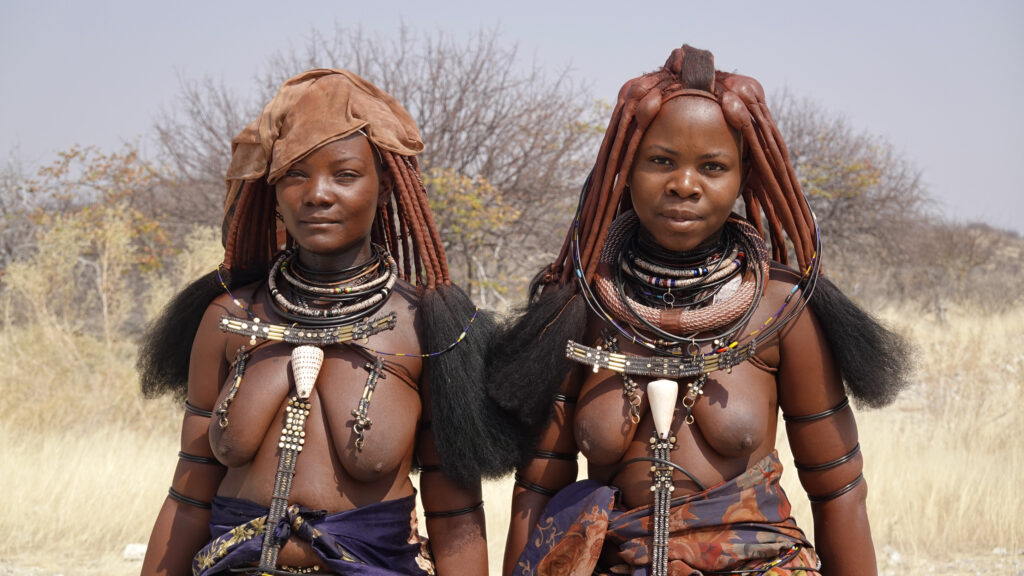
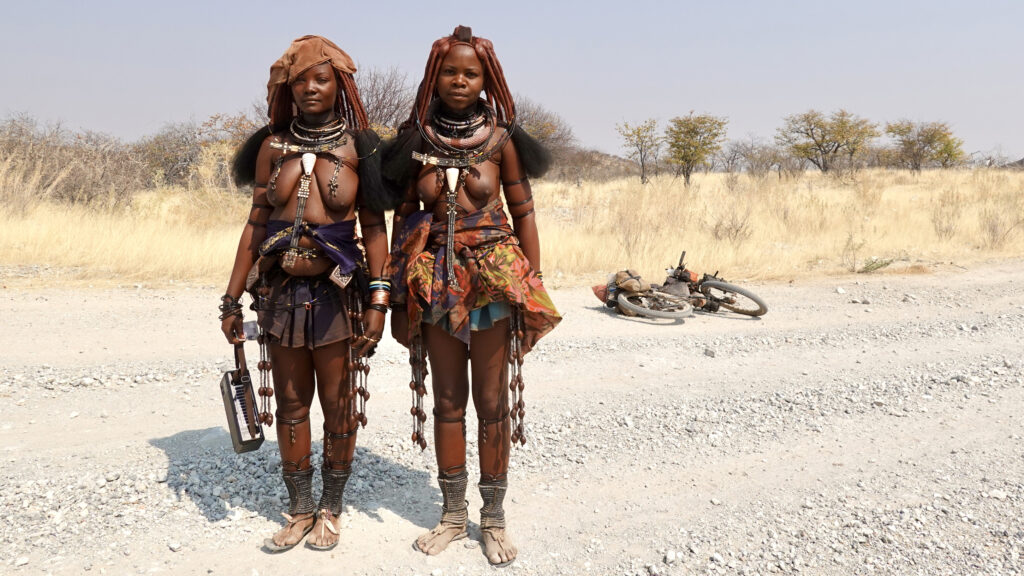
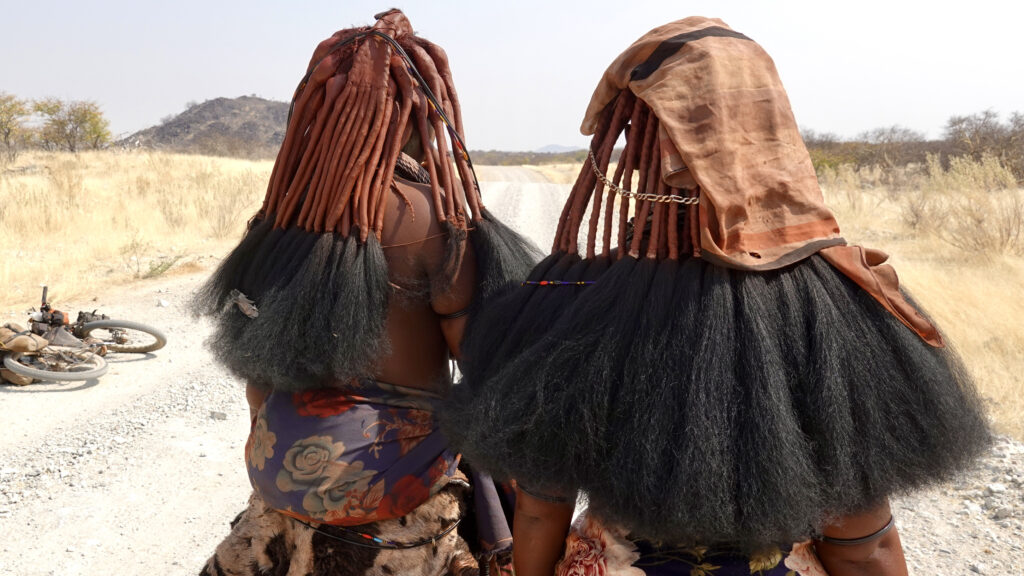
A world of difference
Many people ask us for money when we meet them. Especially the Himba in northern Namibia. And it is clear that many do not have much for themselves. Even though we think we have only a few things on the bikes, we still have a huge abundance of clothes, equipment and food, compared to an ordinary person in the countryside of Namibia. A Himba family lives in small huts, and they still largely live off their cattle and as hunters/gatherers. That is, they eat what nature has available. During the dry periods, they have to move to where there is water and food. It's pretty crazy to think that in 2024, some people, like ourselves, live in an apartment where we can turn on the faucet and clean drinking water gushes out at any time, while other people have to move their homes, to access a water source that is barely dried up. At the same time, they eat leaves, roots, caterpillars, etc., while we simply go down to the supermarket and tear things off the shelves.
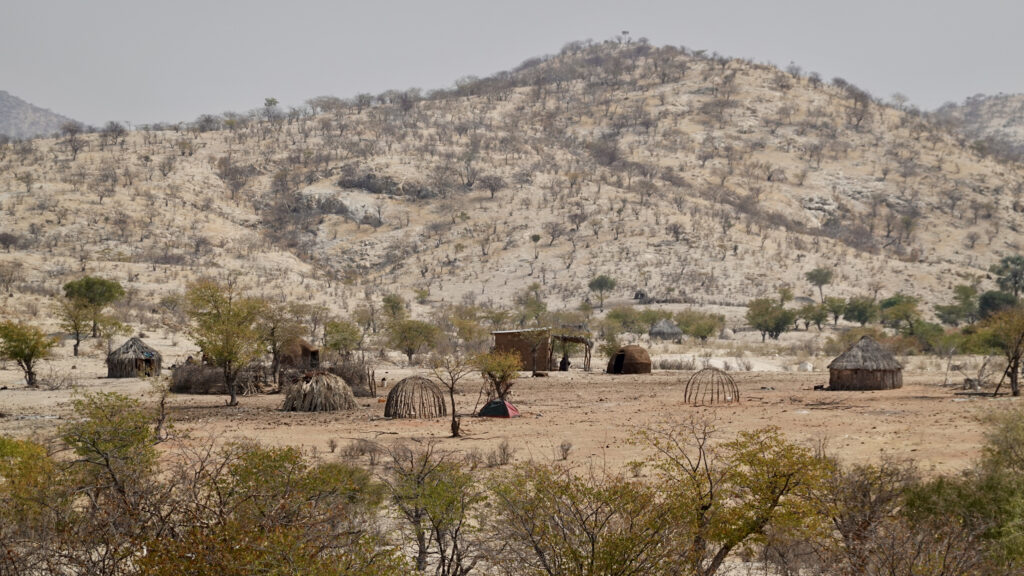
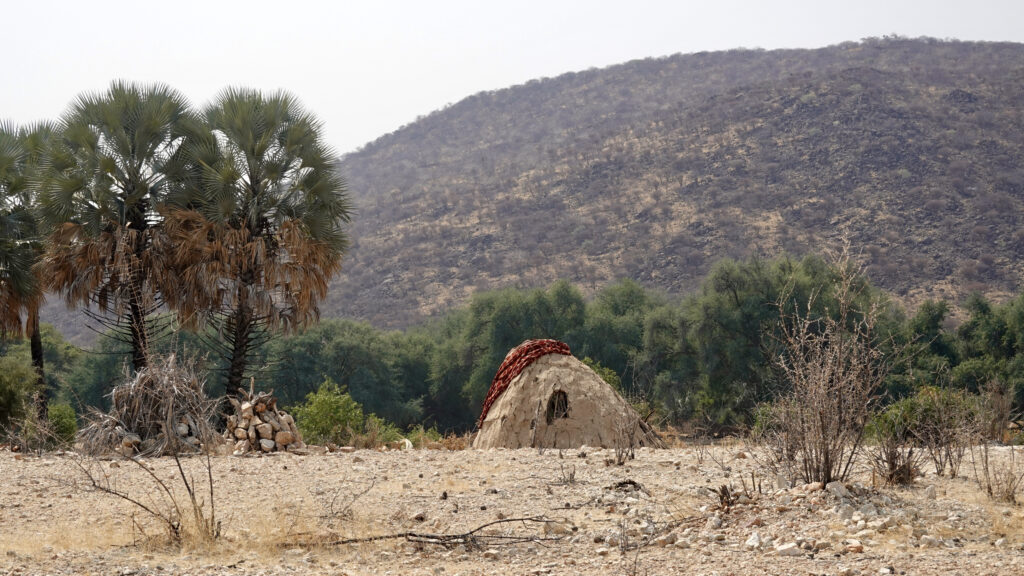

Terrible animals
In Epupa we loaded the bikes with food for 5 days and water for 2 days. Ahead lay gnarled, winding paths through a rugged terrain of sand and rock. Silent landscapes in flickering heat haze. Home ground for both lions, rhinos, elephants, snakes, scorpions and giraffes. Animals we wanted to see but not be killed by.
The first animals we saw, however, were the ultimate master of the art of irritation: the fly. As soon as we climbed from the unbearably hot valley, to the airy plateau, the flies took shelter on our backs, whence at regular intervals they took a mad flight, at full speed round our faces. In the dry desert, the flies seek even the smallest bit of liquid, so they constantly crawled under the sunglasses, on our sweaty cheeks. They went after the eyes and nostrils, even the ears had to be invaded. When 5-10 flies are simultaneously crawling around your face, while trying to balance the bike through large rocks or deep sand, patience is really put to the test. The arms wave wildly around. Breathing and profanity help a bit too. But only for a short time. The rule in Africa seems to be that the smaller an animal is, the more annoying and the more damage it can do.
We both swallowed a few flies which we spat back out.
Only Marie had been smart enough to bring a net for her head. Kenneth had ample opportunity to train his Zen Buddhist calm.
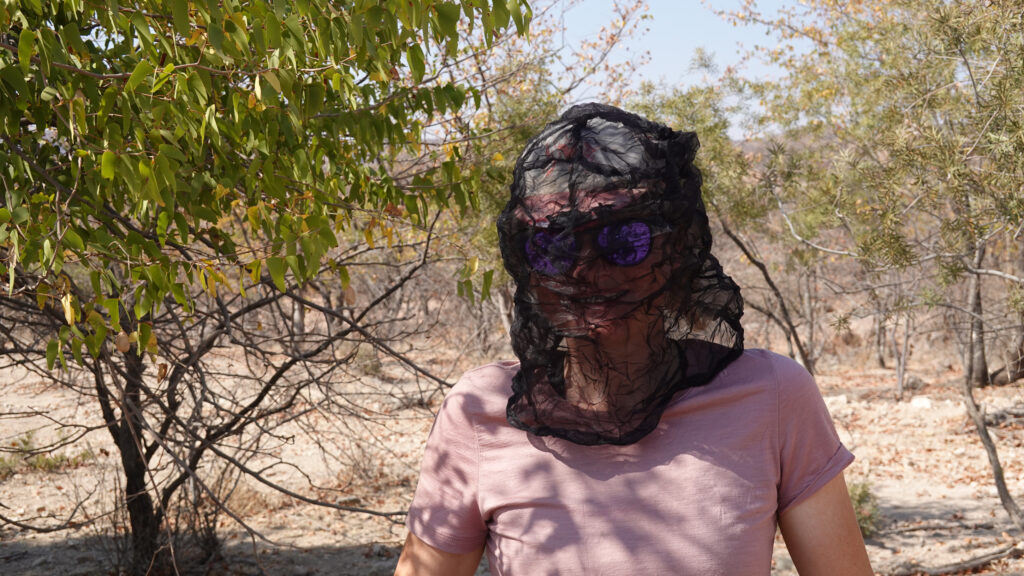
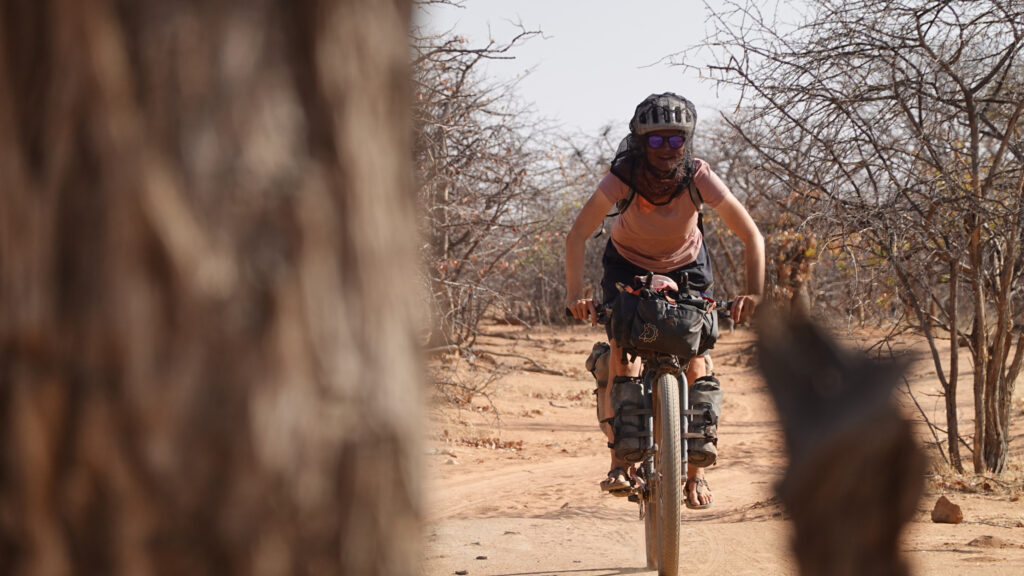
The route planning
A South African bikepacker has dedicated the last years of his life to finding a route through this deserted but animal-rich corner of Namibia. A route that can actually be cycled without dying of thirst. Because there is a natural limit to how much water we can carry on the bike and how far we can cycle in a day.
He has called the route SAND, and it has become an enormous work. More than 5,000 continuous kilometers through South Africa and Namibia.
In our research of Namibia, we put a lot of pins in the map, as always, with the things we wanted to experience. When we saw that SAND connects almost all these points, with beautiful cycling in desolate landscapes and at the same time avoiding the many fences, private land and national parks that we are not allowed to cycle through, it was an easy decision to let Johan's massive work benefit us .
However, that doesn't mean we could just sit back and cruise while the GPS did all the work. On the contrary, Johan has succeeded in creating a route which is so difficult and challenging that we constantly had to think very hard about provisioning, especially water, in order for it to be possible. We each had 10-12 liters of water on the bikes when we were completely full.
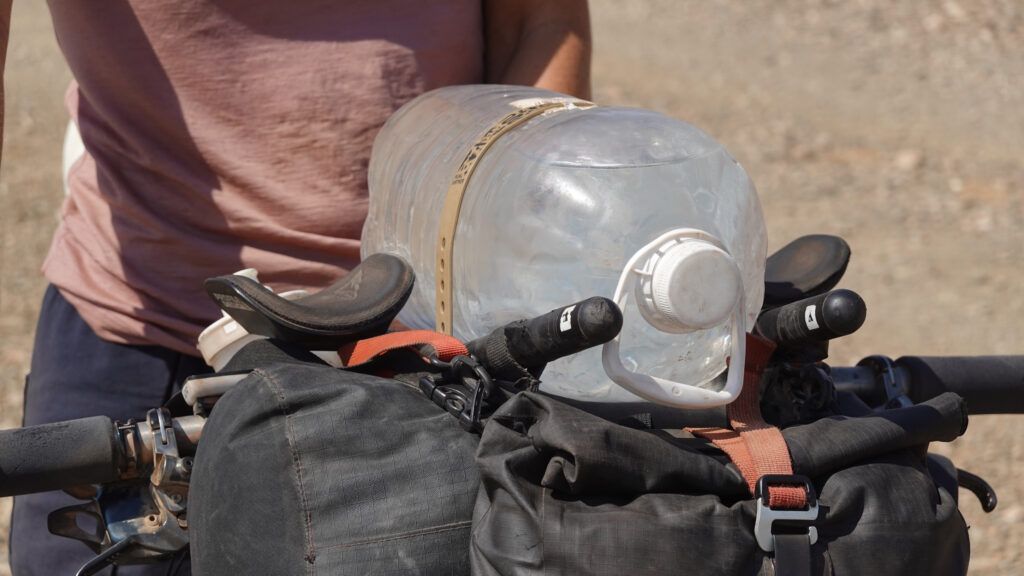
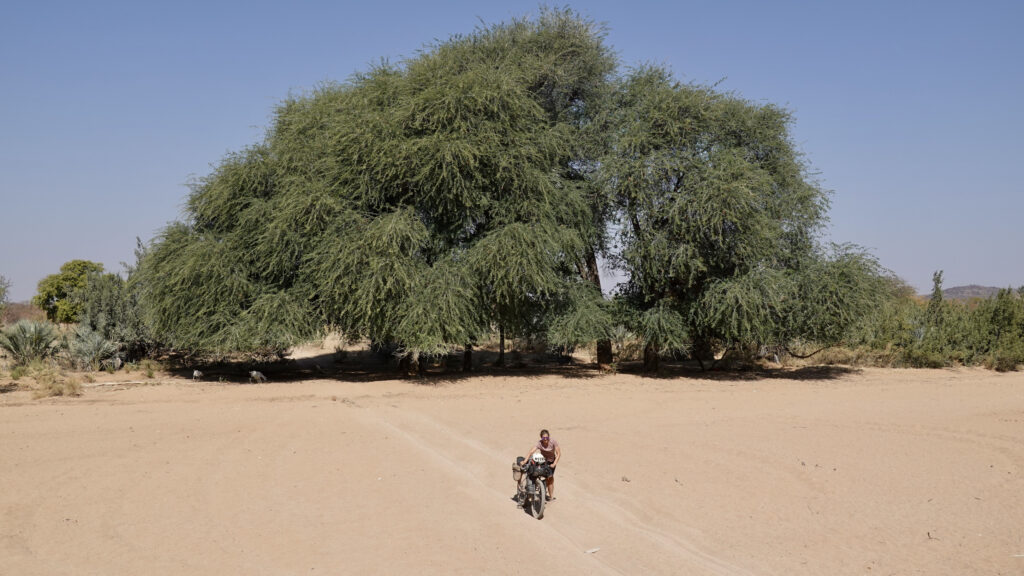


Difficult terrain
One of the most difficult sections of the route is already at the start, after just a few days of cycling. Van Zyl's Pass is a steep and rocky passage that took us from the high plateau down to the flat sandy desert. The place is notorious among the 4×4 people, who consider it the ultimate challenge in Kaokoland. It's one of those places you don't drive to if you only have one car. If something happens to the car, you are so far away from everything that help is virtually impossible to get hold of.
But such passages are usually easier for us on the bike, and our advantage was that we had to cycle down the Van Zyls, not up. But the biggest challenge for us was not even the terrain. What was far worse than large loose rocks on a steep descent is that Van Zyls is so far away from everything that we started to run out of water. The last town was 80km ago, the heat was unbearable and we drank more water than ever before. And the worst part was that even after Van Zyl's challenging descent, we still had 80km of cycling through a sandy uphill plateau until the next town where we could get water. All in all, we were in a bit of a serious predicament. The math for the water supply just barely worked out, and we knew it would be more than serious to run out of water here in the desert.
But as if sent from heaven, we caught up with a group of four 4×4 jeeps, which crept down on the Van Zyls. Marie rolled onto the side of the rear car, smiling big, and waved at them through the side window. They were shocked, but immediately stopped the car and rolled down the window. They were a little dumbfounded to see a couple of cyclists out here in the middle of nowhere, but they were quick to stick a couple of bottles of cold water out the window.
At the bottom of the descent, all four cars stopped and everyone got out, breathing a sigh of relief at their successful descent. Suddenly one woman became ill. She had to sit down. Kenneth got one of the others to help so that we could carry her into the shade and loosen her tight warm clothes. Meanwhile, Marie found electrolytes for her and mixed it in a bottle of water. After 5 minutes she was upstairs again. The heat had knocked her over.
The people were very grateful for our help and it dawned on them how vulnerable a situation we are in, on the bikes. So now there was no limit to how much water we could get. We filled up our bottles, and thus the math until the next water station suddenly fit much better, with a plus on the bottom line.



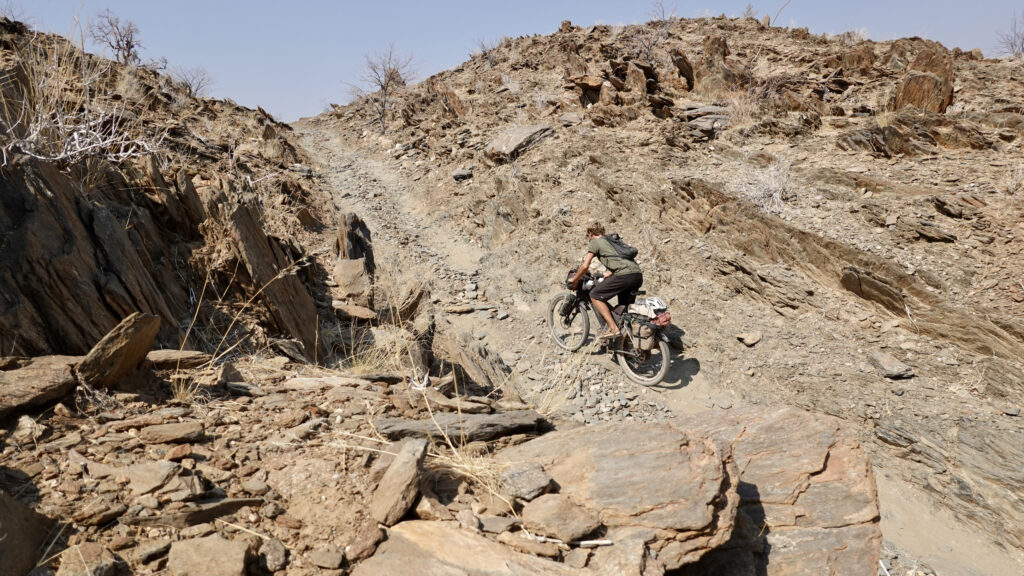
The next day we met the 4 jeeps again. We were cycling up the gnarled Joubert Pass when we saw them approaching in the distance. Kenneth couldn't stay in his skin and had to test that even uphill in technical terrain, a bikepacking bike is faster than a 4×4 jeep.
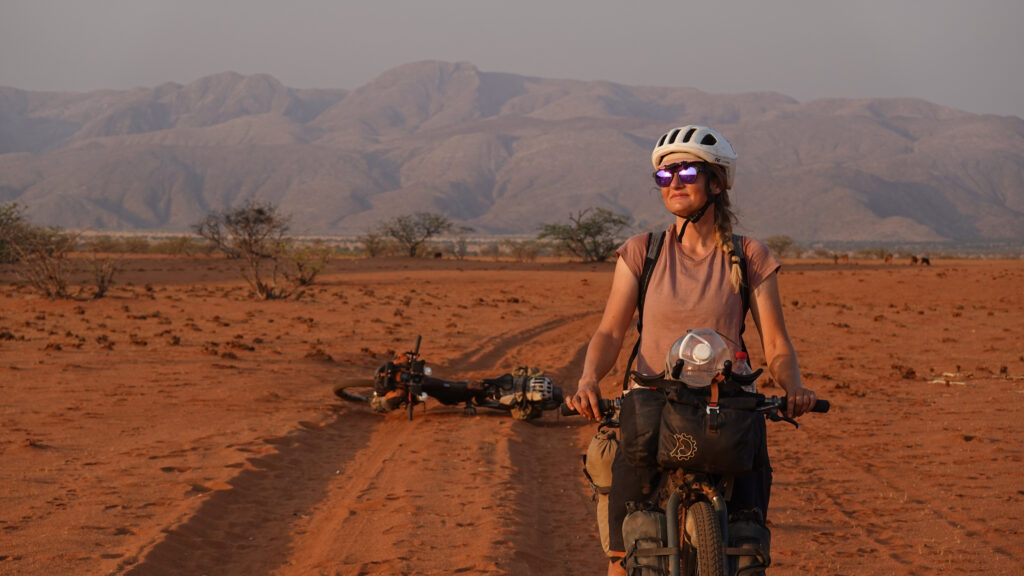

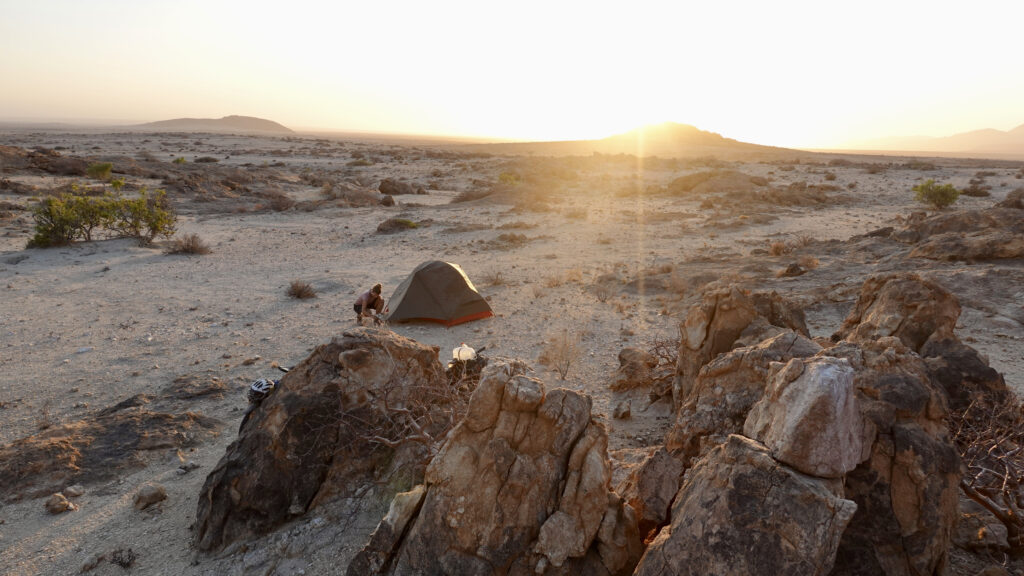
We merge with nature
The heat haze flickers over the endless rocky desert landscape. There is not a sound to be heard. Only the rush of blood in our own body when we stand still. Or the sound of the tires rolling over the crunching ground when we cycle. It is completely enchanting and breathtaking. Being alone in these landscapes of vast open sky opens the soul and the mind. The eyes adjust to see far, instead of being limited to short vision. The ears pick up the slightest breath of wind in the immense silence. But it is also vulnerable, and we are always fully aware that small mistakes in this desolate desert can quickly grow into fatal problems. It causes a slight uneasiness which is constantly lurking in the back of the mind.
We cycle for almost a whole day through a flat landscape of red sand, with scattered rocks that stick up like small islands. At the end of the day, we camp up on a rock block and feel how the rocks protect us with their warmth all night, even though the surrounding desert is freezing cold. Above us, the stars flicker wildly in the night sky, and when the moon rises, it becomes so bright that the enchanting rocky landscape casts crooked shadows in the sand. We feel deeply connected to nature, and we think about how extremely difficult it must be for the Himba to live in this barren landscape. The skills and understanding of nature they must possess in order to obtain water and food is enormous. Something we, in the modern world, have completely lost. We wouldn't survive long here if we hadn't brought food from the supermarket.

Leaving the hot rock wall the next morning, we cycle towards one of the highlights of the route. We reach a hilltop and in the next valley a wild sight unfolds before us. A river bed with a paradise of green trees winds through the gray rocky desert. But the river has no water. It's crunchy. It is only white sand. An elongated oasis. Both for our eyes, but also for the animals. We don't cycle along the river bed for long before we spot a black dot between the trees. An ostrich follows us curiously. And immediately after, we are giddy when we see a couple of long necks sticking up above a treetop. Giraffes!!! It is absolutely amazing to see them, even if they are far away. They move majestically. A few kilometers further on, 6 giraffes suddenly run out of the riverbed and directly across the dirt road in front of us. When they run, it looks like it's happening in slow motion because of their long necks. They stop and study us carefully. We do the same. The curiosity is mutual.
We smile big and enjoy being here, where the animals from the Zoo roam freely.

Wild animals - up close
A few days later we have a rest day in Sesfontein. A tiny town which, however, has a lodge where we have been allowed to camp in the garden, for a fraction of the price.
An Italian couple on summer vacation have booked a safari in the Huanib River for the next day. We know it's one of the best places in Namibia to see wildlife if you don't want to go to Etosha with thousands of other tourists. We decide to sign up for the trip.
The next day, Ernosto, our guide, picks us up in an open safari vehicle. It takes some getting used to for us, to let go of the bicycle identity and exchange it for "White tourist on the back of a four-wheel drive". But as soon as we get down into the Huanib riverbed, it all makes sense. We see everything from the open car and before long a large male elephant walks out onto the steppe, next to us. It is on its way to its watering hole. We are bubbling with joy to be so close to the big animal, without being in danger. After all, the car offers slightly better protection than the bicycle.
We meet several elephant families with small cubs. The smallest baby elephant is just two weeks old. The mothers tear branches from the trees with their strong proboscis and munch on them while the cubs brood.
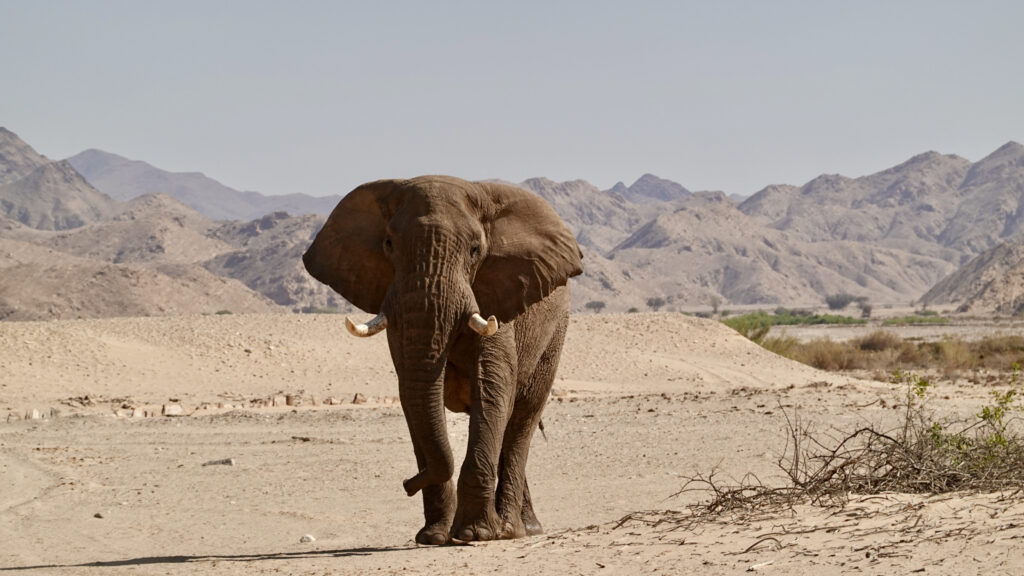

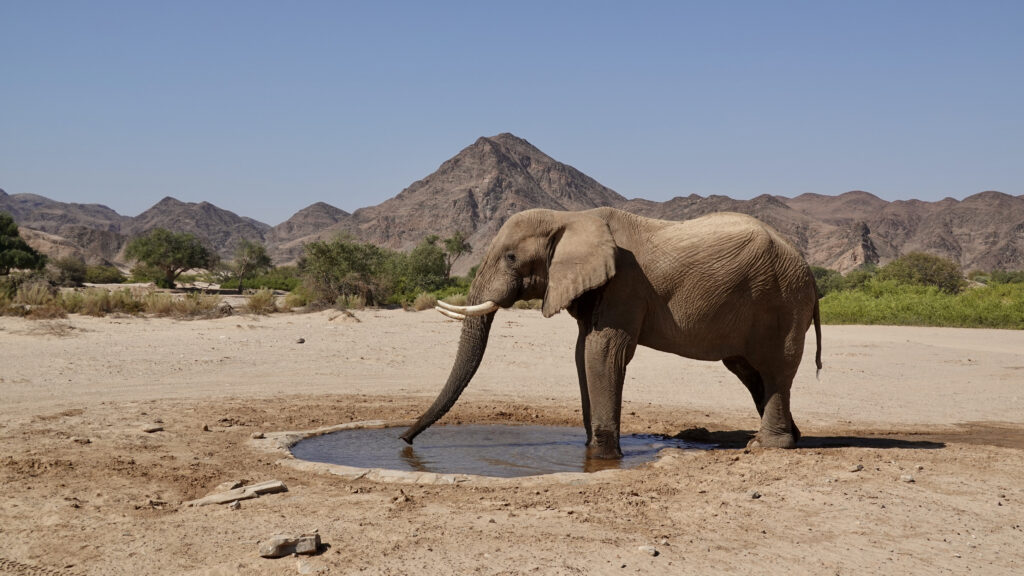
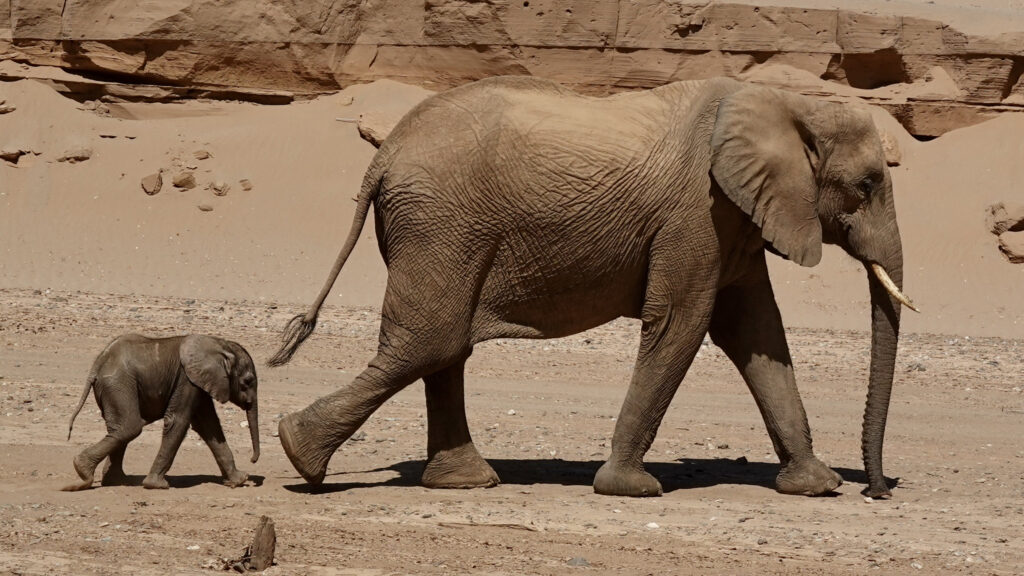
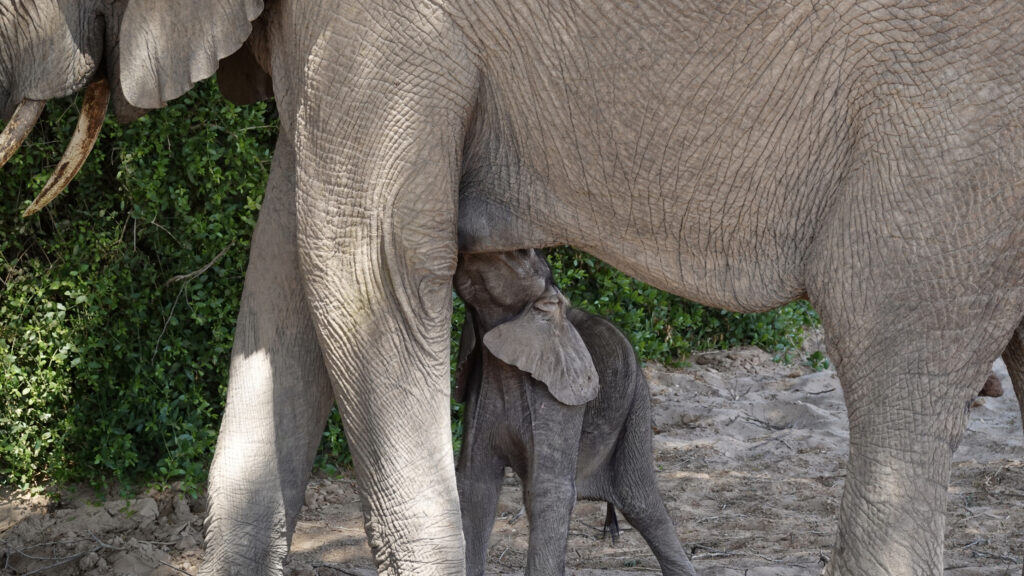
Ernesto navigates us with a sure hand through the dry sandy riverbed. He has previously worked with tracking rhinos, so he knows exactly what he is doing. And he doesn't give up. He spots fresh footprints from a lion. He drives back and forth while trying to figure out where it is hiding, at the same time as he searches the lion's usual hiding places. He drives the car all the way into a dense bush and suddenly Marie exclaims: "There it is!". Only a broad nose and two eyes peek out from behind a bush. We must have woken the lion from a nap so he gets up and stretches. We sit very still and watch him until he gets tired of us and sneaks into the thicket.
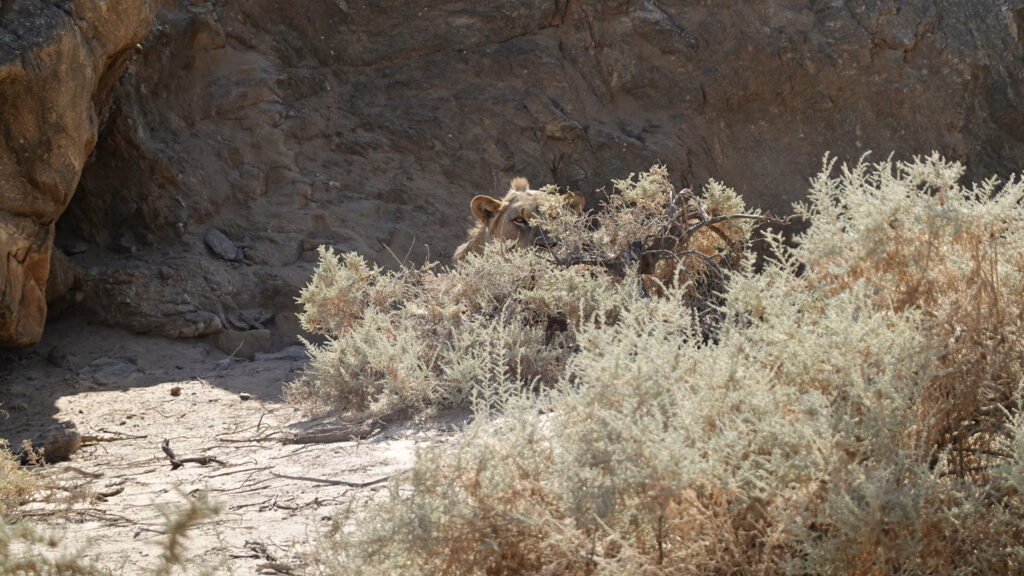
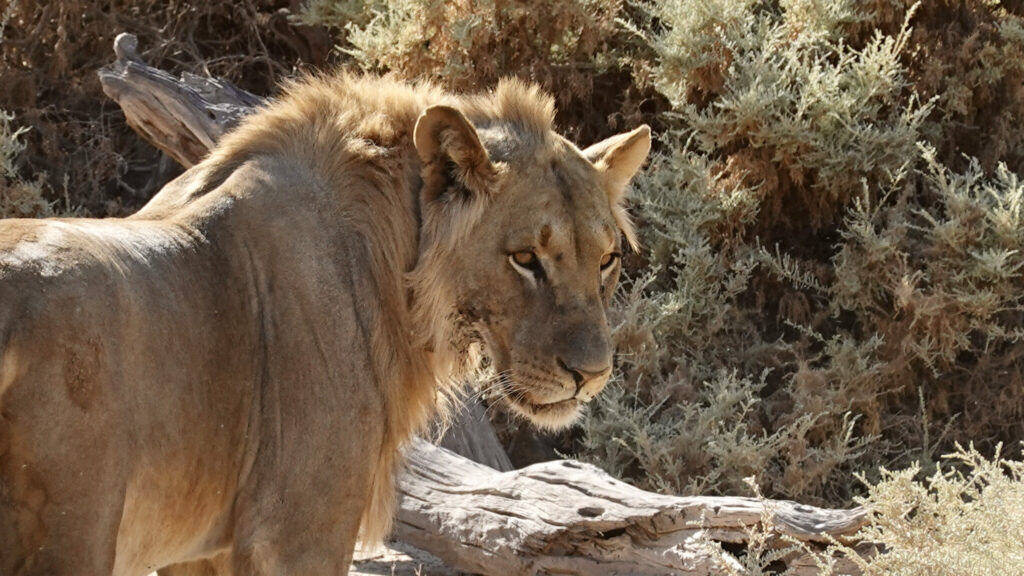
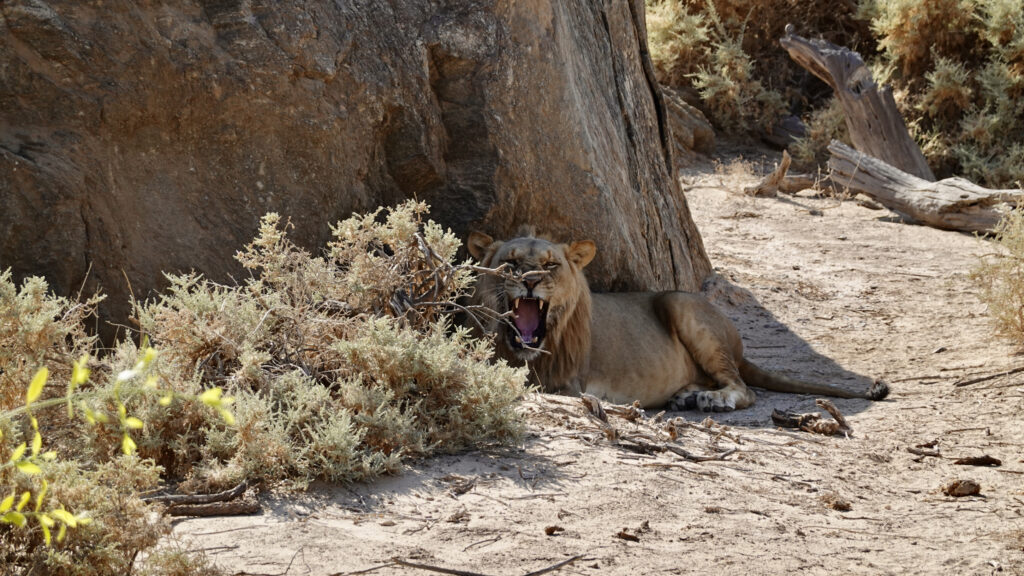
Giraffes are there in the hundreds. When we meet them on the bike, they become shy and hide or run away. But they are used to the car and know it is not doing anything, so we can get much closer and see the beautiful animals than we have done before.
In one place we see a giraffe standing all alone in the wide river bed. Ernesto stops the car. "It is in the middle of the danger zone!". A little before, we have seen a lioness walking down through the river bed, towards the giraffe. Ernesto says that the lion will probably attack the giraffe. It's only been a little over a week since it last happened. We sit quietly and wait. Nothing happens. Ernesto drives around a bit to find the lion, while we keep an eye on the giraffe, who unsuspectingly struts around like a fragrant ham at a Christmas buffet. We are divided on the idea of how wild it will be to see a lion attack a giraffe, at the same time it is also a repulsive thought. But we have no choice. It is Ernesto who has the keys to the car.
After half an hour, however, he no longer believes it and drives away. After just 5 minutes of driving, we see the lion again. She has missed the giraffe in one of the overgrown places in the river bed. But as soon as we see her, a small antelope, a springbok, comes around the corner. The lion stands motionless in the shadows. The springbok looks away for a moment and the lion sneaks into the undergrowth. We stop the car at a distance and keep the camera ready. The springbok comes down towards us unsuspecting. It stops. There's something in the air. Sensing something going on. Suddenly the lion comes out of the thicket at full strength. The springbok turns around and runs as hard as it can. The lion chases it, but the springbok is extremely fast and the lion only has a short sprint before it has to give up.



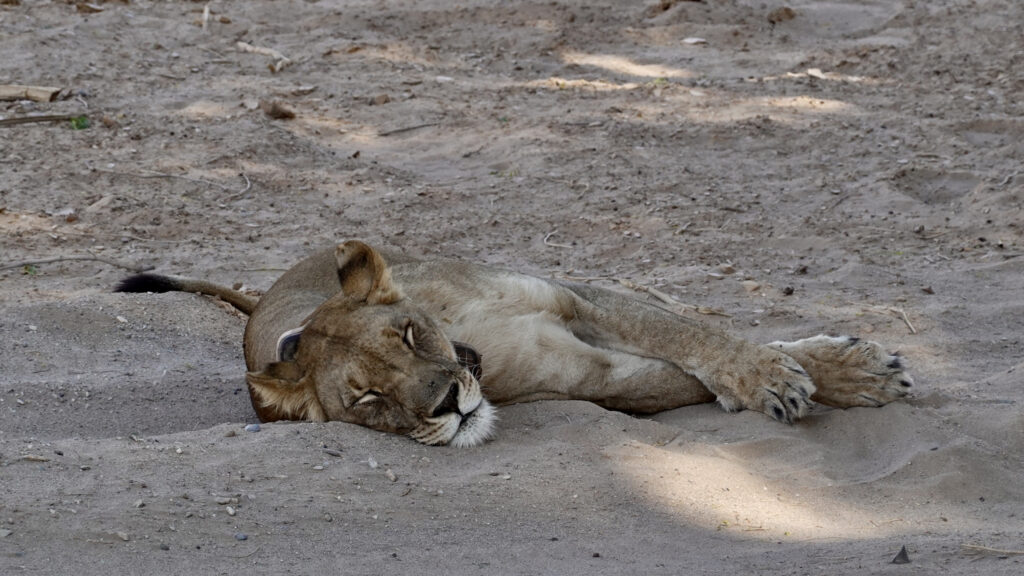
She is tired and lies down in the shade of a tree, close to us, to rest. The springbok returns and looks as if it intends to slip past. The lion raises its head. But we never get to know how it would have ended, because another car shows up and ruins the scene, sending the springbok running the other way.
Bikepacking belisimo
The image most of us have on our retinas when we think of Africa is probably a fiery red sun setting over a flat savannah with a solitary acacia tree and a silhouetted giraffe. Africa is anything but that image. But if you want to experience that atmosphere, Namibia is the place to go.
We are completely in love with the vast landscapes here. And the wildlife. When we camp in the evening, it is beautiful to see the light change in the sunset. To feel the temperature drop to a tolerable level. To feel the calm descend in the vast wild landscape. When we wake up, the same scenario plays itself out backwards. Or forwards if you want. The sun rises and colors everything golden. It breathes life into our cold bodies with a warm wind. It's easy to start a new day when mother earth goes to such trouble with a beautiful start.
The SAND route that we follow is not only a gpx file, but also has a description. However, we find time and time again that the places described as difficult are actually quite easy. On the other hand, there are often passages where we unexpectedly have to get off the bikes and push them through deep sand, or spend a long time finding the track, because there is practically no road where the route goes. The pace is at rock bottom. Most days on the route, our average speed is 7km/h including breaks. We have never moved so slowly on the bikes before.
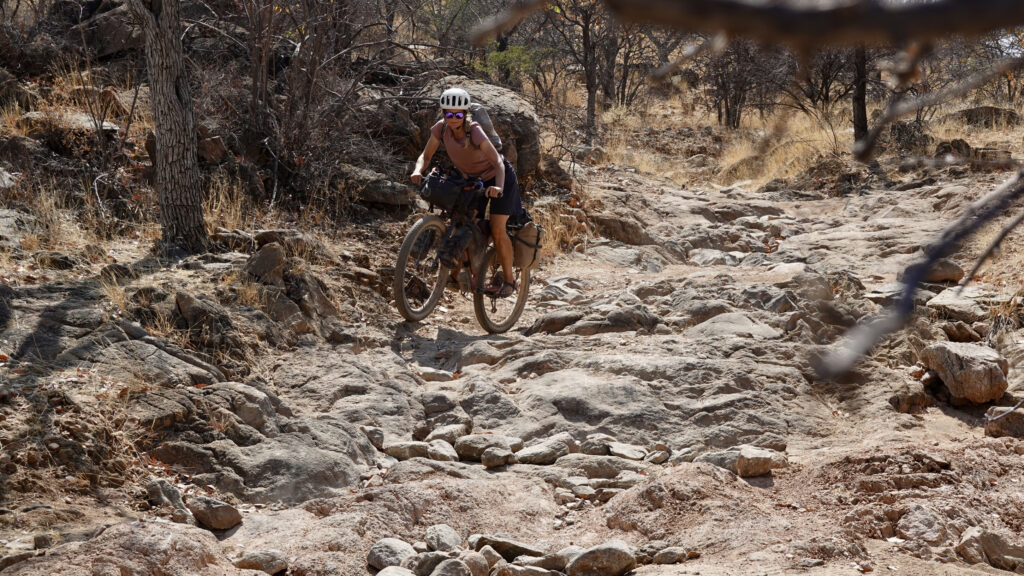
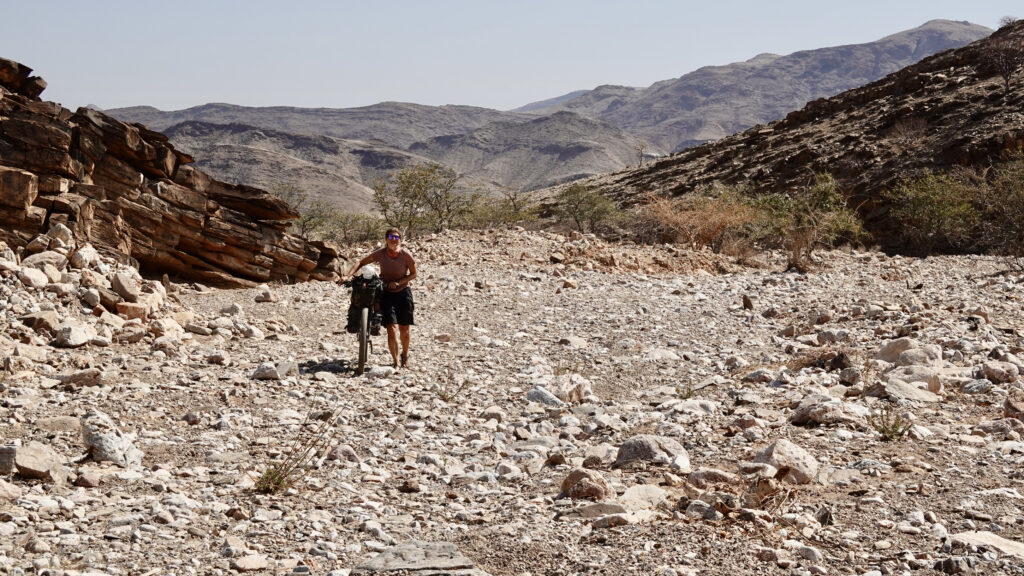


Map vs reality
One day we will drive through two riverbeds. In the first, the sand is fairly compact. We let air out of the tires so they have a larger tread surface. This allows us to ride in the sand, even if it is right on the border with the heavy bikes and relatively narrow tires. In reality, a fat bike would be ideal here. But it works and it's really fun to cycle in the riverbed. But in the next river bed the route makes no sense whatsoever. The sand is perfectly fine and soft. We sink in far too much. We try a few hundred meters, but quite quickly make a decision to get out of the riverbed again. It is almost 20km long, and if we have to push the heavy bikes in deep sand, it will be 3km/h. This means that it can quickly take 5-6 hours to get through. Instead, we find a great 4×4 route that winds along the river, where we both have views from hilltops, but also descend into the river where it is compact and drivable. You must never blindly follow other people's routes. Instead, it only takes us 2 hours to drive the river bed.
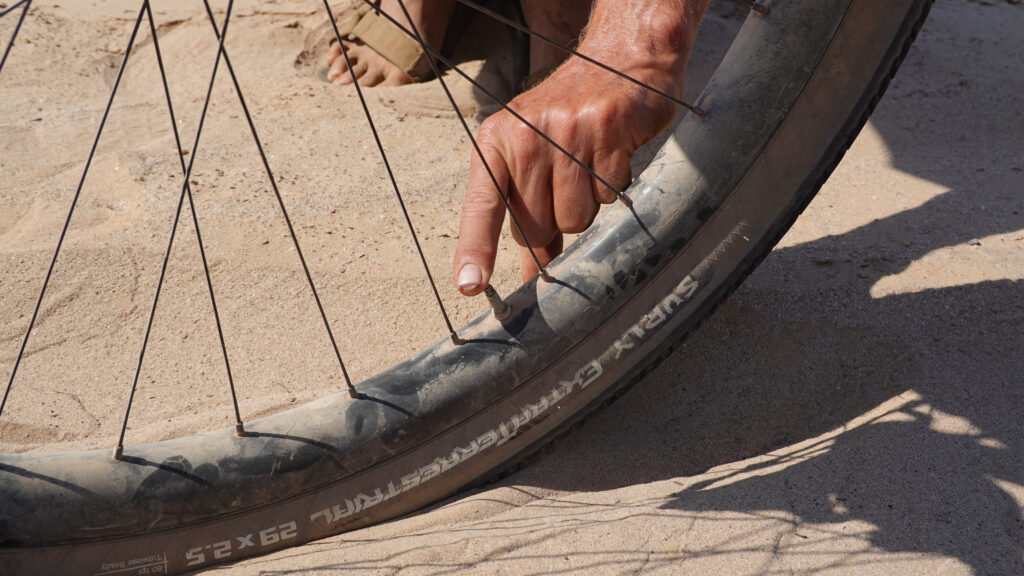
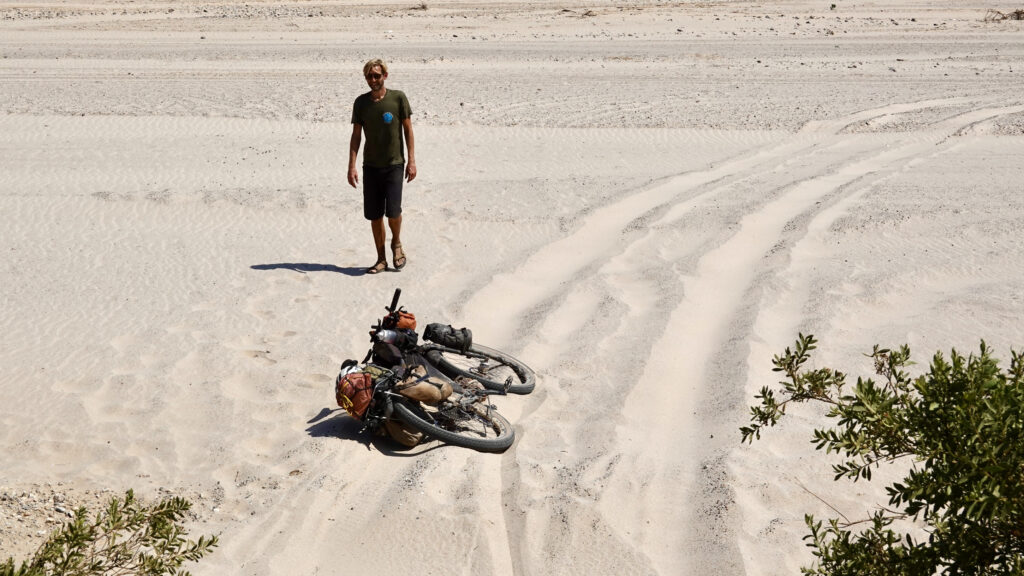
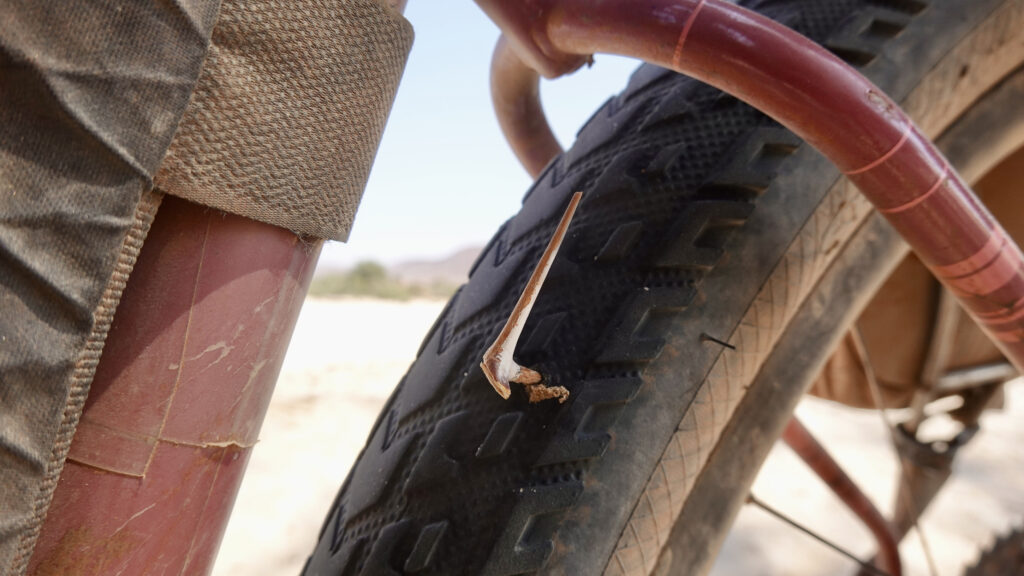
But it's all the challenges and a certain element of uncertainty that make it all worth cycling here. We love when there is room for interpretation and own planning. Namibia is a mecca for bikepacking. The best adventures are always those without guarantees, where there is some risk as to whether it will even be possible to complete. But which rewards one with unpredictable experiences of great beauty. And SAND and Kaokoland contain exactly that. We love it!


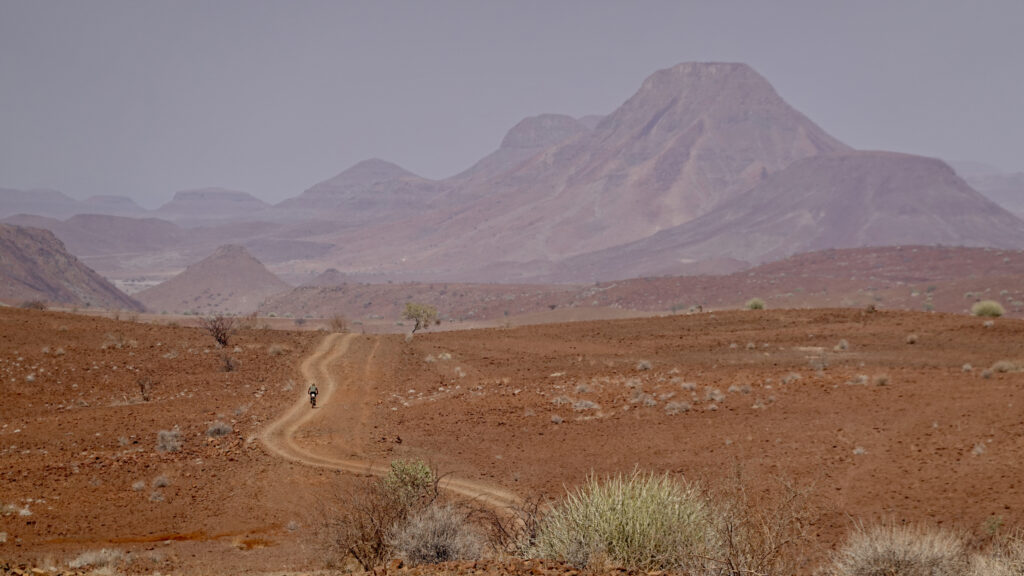
Exploring new terrain
This segment of the SAND route ends in Swakupmund. We are looking forward to a small mini-holiday with luxury and lower temperatures, in the small coastal town.
But first we have to solve a small problem on the route.
Johan has laid out the route over a long stretch of a busy main road. For the last 1,500km we have not touched asphalt, so we are making an extra effort to find an alternative to the deadly, and dangerous, main road.
We also contact Johan and together with him we put together an alternative route that has not been driven before.
We set off from Spitzkoppe with big smiles and a sense of adventure.
When we turn onto our own route, we not only find the first tailwind of the trip, but also a really good and fast gravel road. The mood is high.
We take a lunch break in the shade under an acacia tree, and while we are munching on the usual French bread with peanut butter, a young guy comes out of the blue and asks: "Are you guys lost or what?". No tourists usually come here and we appreciate his concern for us but assure him we know where we are.
Already early in the afternoon, we have covered the first 70km of the day, which is usually a day's distance. But there is more powder in the legs and more time and it is a huge advantage that we can tackle the most unknown part of our alternative route already today.
We ask a guard at the gate of a mine if we can get water. He shares his own water jugs with us. Then we cross the busy main road and dive down towards the dry bed of the Khan River.
We have no idea what awaits us. If we can cycle here. If there is even a way through. The feeling is good though.
The desert landscape changes character. The plants are characterized by extreme drought. It's insanely hot. The thermometer on the bike computer shows 45 degrees. However, it sits directly in the sun. But we do too. The air is completely still and crisp. Our tongue feels like a rockfish. Rough, dry and salty. We drink and drink but are still thirsty. A headache presents itself, but we have to conserve water, because the route through the riverbed is 75km until the next water point, and we have no idea if it is deep sand all the way.
We move down through small tributaries towards the Khan river itself. The sand is deep here. There is some kind of road in the sand, but it is completely plowed up, so we are forced to drive beside it, through low bushes that tear our shins. But it works. As we approach Khan, the cliff sides stand tall around us, reflecting the heat. It is unbearably hot. It affects our mood, and we get angry over small things. We have to push the bikes in the soft sand. Gradually we get through. Although we are under pressure, we take in the beauty. It is a very special landscape. And here we are completely alone.


When we finally get out into Khan's wide riverbed, we feel the liberating wind on our faces. Even though it's hot like a blow dryer, it does a good job. The sand becomes compact under us and we can jump on the bikes again. The speed increases considerably and the mood goes up with it. We drive from tree to tree. From shadow to shadow. We are still rationing the water, but are more hopeful.
We see lots of animal tracks. What makes the biggest impression are fresh tracks from a lion. We don't want to meet it here in the closed riverbed. While our thoughts revolve around the lion hunt we saw a few days ago, we scout behind bushes and rocky outcrops. However, the only animals we see are monkeys and springbok.
Towards evening we find a place for the tent. We are used to the temperature dropping when the light disappears. But that doesn't happen.
We cook. We only have rice and a can of beans in tomato sauce. It tastes terrible and none of us can get anything down. Partly because of the heat, but by now we've also had enough of bad tinned food. We throw most of it away and go to bed with a handful of licorice sweets for dinner.

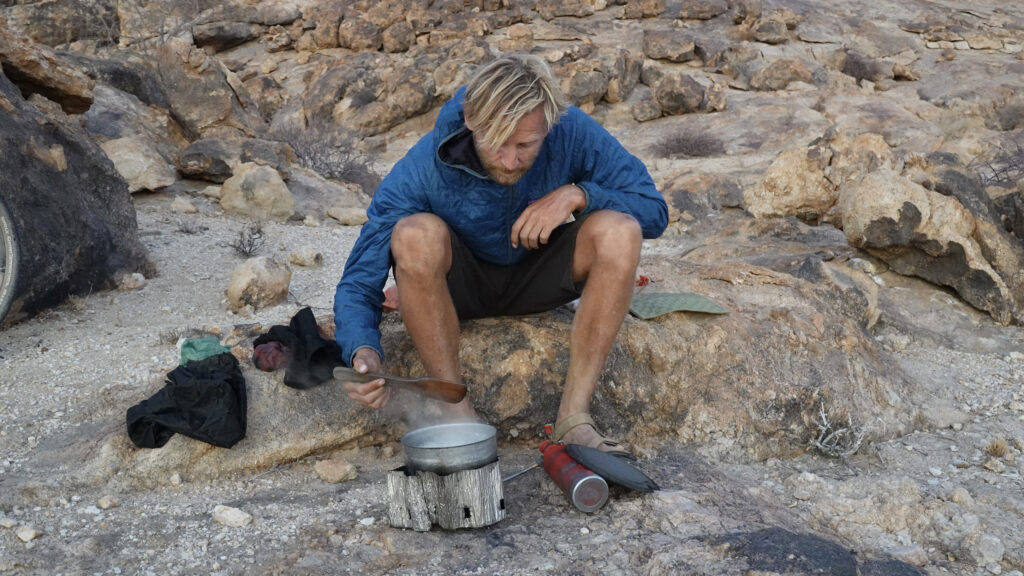
The heat is bothering us. Kenneth puts his mattress outside the tent to cool down a bit. But he gets to throw the mattress on top of one of the pegs so that it is pierced through with a bang. The mood is low as the headlamp and patches are found.
In the middle of the night, Marie wakes up with a set. Shines out of the tent with his headlamp and exclaims: “There's a fox. Tsscchhh. Away!! Phew. Get away!!!”. The fox lists off. But the next morning Kenneth discovers what it was preoccupied with. First, it has stolen our garbage can, which must have had some leftover food. We are embarrassed that some of our rubbish is now floating somewhere in the river bed. We usually tie the garbage bag, but had forgotten yesterday in the heat.
But what is worse, the fox has bitten off the drinking spout of Kenneth's drinking bottle, and it has drunk almost a whole bottle of water. It's pretty critical in a place where we really skimp on water, even so much so that we both have headaches from dehydration. But there is nothing we can do.
We get up and pack quickly to take advantage of today's coolest morning hours.
Fortunately, the surface is good. And the riverbed is really cool, fun and incredibly beautiful to cycle in, with its crooked course and rocky sides.
We are progressing faster than feared. In some places we can even maintain a speed of 25 km/h on the compact sand. The mood peaks when we find out that the camp where we can get water even has a restaurant with good cake.
We are easy to please. But luck was not so much in the cake now. It lay more in the pride of having opened a new part of the route. To be in unknown terrain and make it all come together, despite adversity.
The experience encourages more and instead of taking the last 20km of paved road to Swakopmund, we take a shortcut through another dry riverbed until we pop up in Swakopmund's expensive suburb. Dirty, tanned, smelly and sweaty, but with big smiles. Much to the astonishment of the local pensioners, who are sitting on their veranda with their afternoon coffee.

Now we are looking forward to a mini-holiday in Swakopmund, with a focus on giving the body the calories that we have cheated it for a little too long. We will need them on the next segment of the SAND route, through southern Namibia's huge sand dunes.
